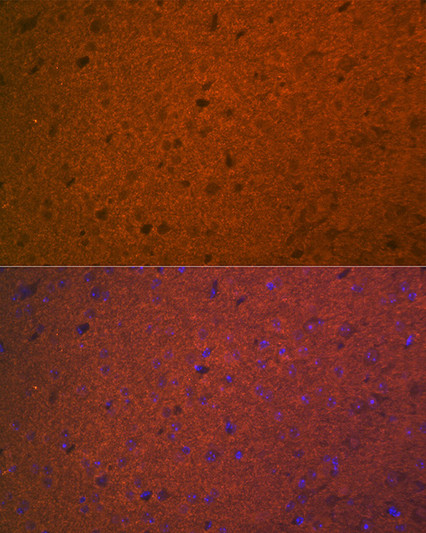| Host: | Rabbit |
| Applications: | WB/IP/ELISA/ChIP |
| Reactivity: | Human/Rat |
| Note: | STRICTLY FOR FURTHER SCIENTIFIC RESEARCH USE ONLY (RUO). MUST NOT TO BE USED IN DIAGNOSTIC OR THERAPEUTIC APPLICATIONS. |
| Clonality : | Monoclonal |
| Clone ID : | S5MR |
| Conjugation: | Unconjugated |
| Isotype: | IgG |
| Formulation: | PBS with 0.02% Sodium Azide, 0.05% BSA, 50% Glycerol, pH 7.3. |
| Purification: | Affinity purification |
| Concentration: | Lot specific |
| Dilution Range: | WB:1:500-1:2000IP:0.5 Mu g-4 Mu g antibody for 200 Mu g-400 Mu g extracts of whole cellsELISA:Recommended starting concentration is 1 Mu g/mL. Please optimize the concentration based on your specific assay requirements.ChIP:5 Mu g anti |
| Storage Instruction: | Store at-20°C for up to 1 year from the date of receipt, and avoid repeat freeze-thaw cycles. |
| Gene Symbol: | RPA1 |
| Gene ID: | 6117 |
| Uniprot ID: | RFA1_HUMAN |
| Immunogen Region: | 1-100 |
| Specificity: | A synthetic peptide corresponding to a sequence within amino acids 1-100 of human RPA70/RPA1 (P27694). |
| Immunogen Sequence: | MVGQLSEGAIAAIMQKGDTN IKPILQVINIRPITTGNSPP RYRLLMSDGLNTLSSFMLAT QLNPLVEEEQLSSNCVCQIH RFIVNTLKDGRRVVILMELE |
| Post Translational Modifications | DNA damage-induced 'Lys-63'-linked polyubiquitination by PRPF19 mediates ATRIP recruitment to the RPA complex at sites of DNA damage and activation of ATR. Ubiquitinated by RFWD3 at stalled replication forks in response to DNA damage: ubiquitination by RFWD3 does not lead to degradation by the proteasome and promotes removal of the RPA complex from stalled replication forks, promoting homologous recombination. Sumoylated on lysine residues Lys-449 and Lys-577, with Lys-449 being the major site. Sumoylation promotes recruitment of RAD51 to the DNA damage foci to initiate DNA repair through homologous recombination. Desumoylated by SENP6. Poly-ADP-ribosylated by PARP1.promoting recruitment of HTATSF1. |
| Function | As part of the heterotrimeric replication protein A complex (RPA/RP-A), binds and stabilizes single-stranded DNA intermediates that form during DNA replication or upon DNA stress. It prevents their reannealing and in parallel, recruits and activates different proteins and complexes involved in DNA metabolism. Thereby, it plays an essential role both in DNA replication and the cellular response to DNA damage. In the cellular response to DNA damage, the RPA complex controls DNA repair and DNA damage checkpoint activation. Through recruitment of ATRIP activates the ATR kinase a master regulator of the DNA damage response. It is required for the recruitment of the DNA double-strand break repair factors RAD51 and RAD52 to chromatin in response to DNA damage. Also recruits to sites of DNA damage proteins like XPA and XPG that are involved in nucleotide excision repair and is required for this mechanism of DNA repair. Also plays a role in base excision repair (BER) probably through interaction with UNG. Also recruits SMARCAL1/HARP, which is involved in replication fork restart, to sites of DNA damage. Plays a role in telomere maintenance. As part of the alternative replication protein A complex, aRPA, binds single-stranded DNA and probably plays a role in DNA repair. Compared to the RPA2-containing, canonical RPA complex, may not support chromosomal DNA replication and cell cycle progression through S-phase. The aRPA may not promote efficient priming by DNA polymerase alpha but could support DNA synthesis by polymerase delta in presence of PCNA and replication factor C (RFC), the dual incision/excision reaction of nucleotide excision repair and RAD51-dependent strand exchange. RPA stimulates 5'-3' helicase activity of the BRIP1/FANCJ. |
| Protein Name | Replication Protein A 70 Kda Dna-Binding SubunitRp-A P70Replication Factor A Protein 1Rf-A Protein 1Single-Stranded Dna-Binding Protein Cleaved Into - Replication Protein A 70 Kda Dna-Binding Subunit - N-Terminally Processed |
| Database Links | Reactome: R-HSA-110312Reactome: R-HSA-110314Reactome: R-HSA-110320Reactome: R-HSA-174437Reactome: R-HSA-176187Reactome: R-HSA-3108214Reactome: R-HSA-3371453Reactome: R-HSA-3371511Reactome: R-HSA-5358565Reactome: R-HSA-5358606Reactome: R-HSA-5651801Reactome: R-HSA-5655862Reactome: R-HSA-5656121Reactome: R-HSA-5656169Reactome: R-HSA-5685938Reactome: R-HSA-5685942Reactome: R-HSA-5693607Reactome: R-HSA-5693616Reactome: R-HSA-5696395Reactome: R-HSA-5696397Reactome: R-HSA-5696400Reactome: R-HSA-6782135Reactome: R-HSA-6782210Reactome: R-HSA-6783310Reactome: R-HSA-6804756Reactome: R-HSA-68962Reactome: R-HSA-69166Reactome: R-HSA-69473Reactome: R-HSA-912446Reactome: R-HSA-9709570 |
| Cellular Localisation | NucleusPml BodyEnriched In Pml Bodies In Cells Displaying Alternative Lengthening Of Their Telomeres |
| Alternative Antibody Names | Anti-Replication Protein A 70 Kda Dna-Binding Subunit antibodyAnti-Rp-A P70 antibodyAnti-Replication Factor A Protein 1 antibodyAnti-Rf-A Protein 1 antibodyAnti-Single-Stranded Dna-Binding Protein Cleaved Into - Replication Protein A 70 Kda Dna-Binding Subunit - N-Terminally Processed antibodyAnti-RPA1 antibodyAnti-REPA1 antibodyAnti-RPA70 antibody |
Information sourced from Uniprot.org











